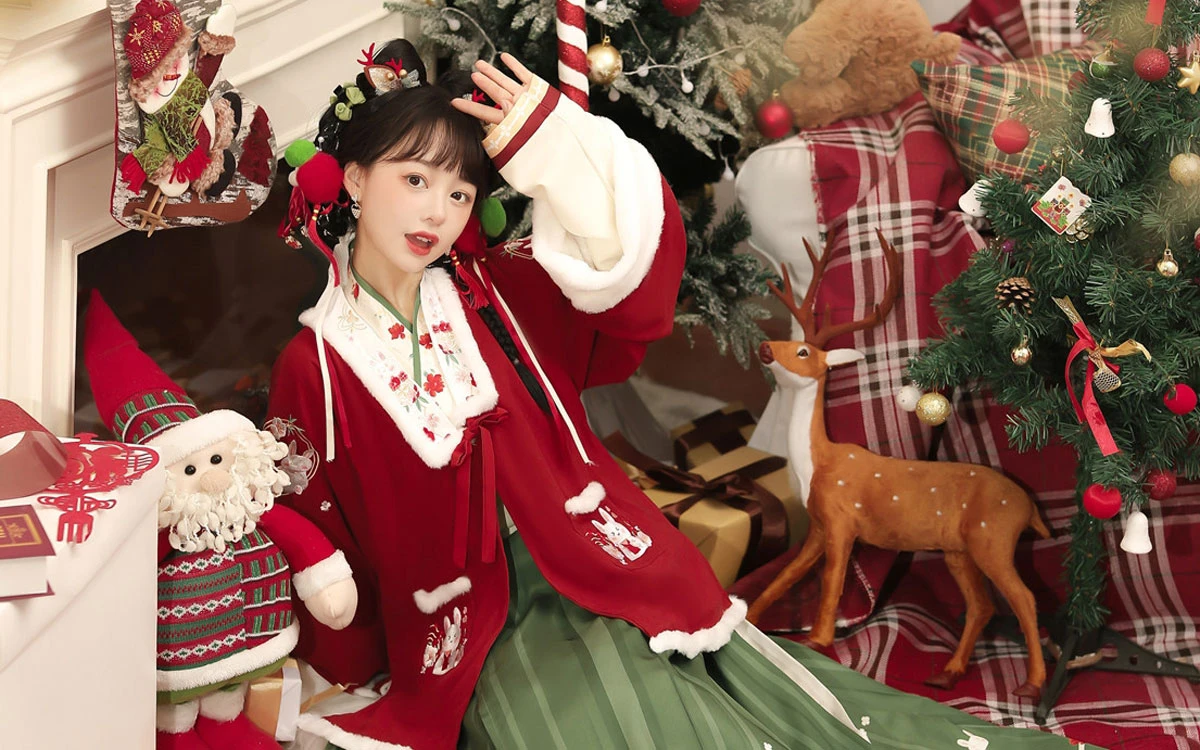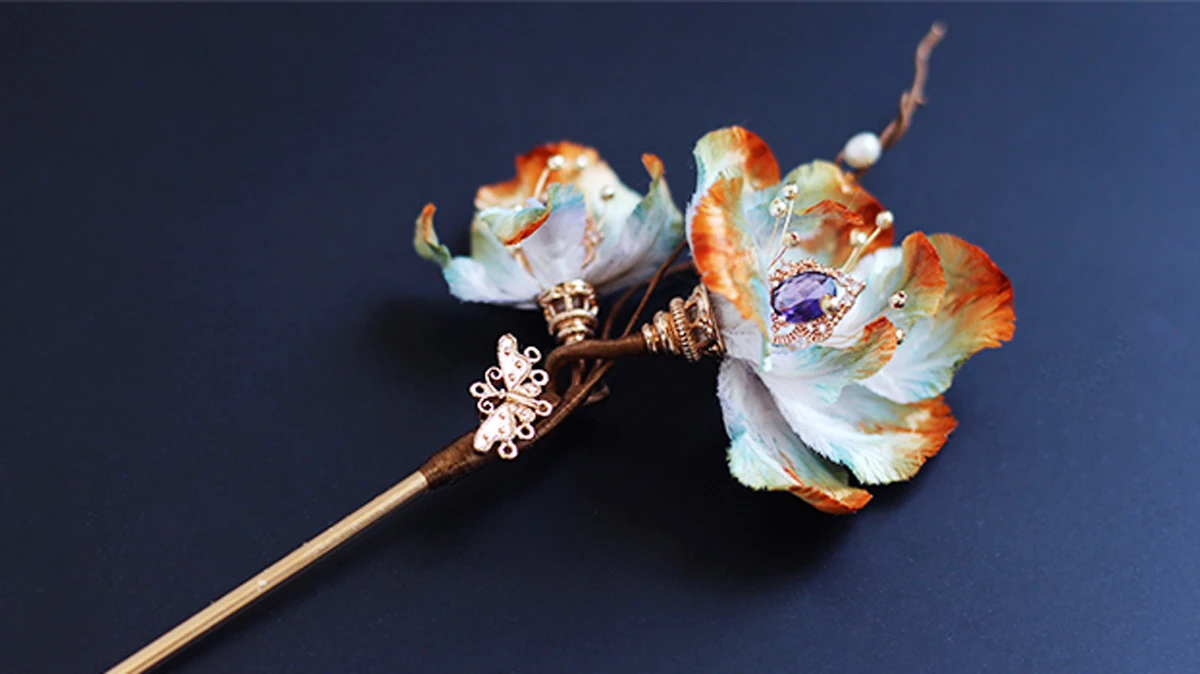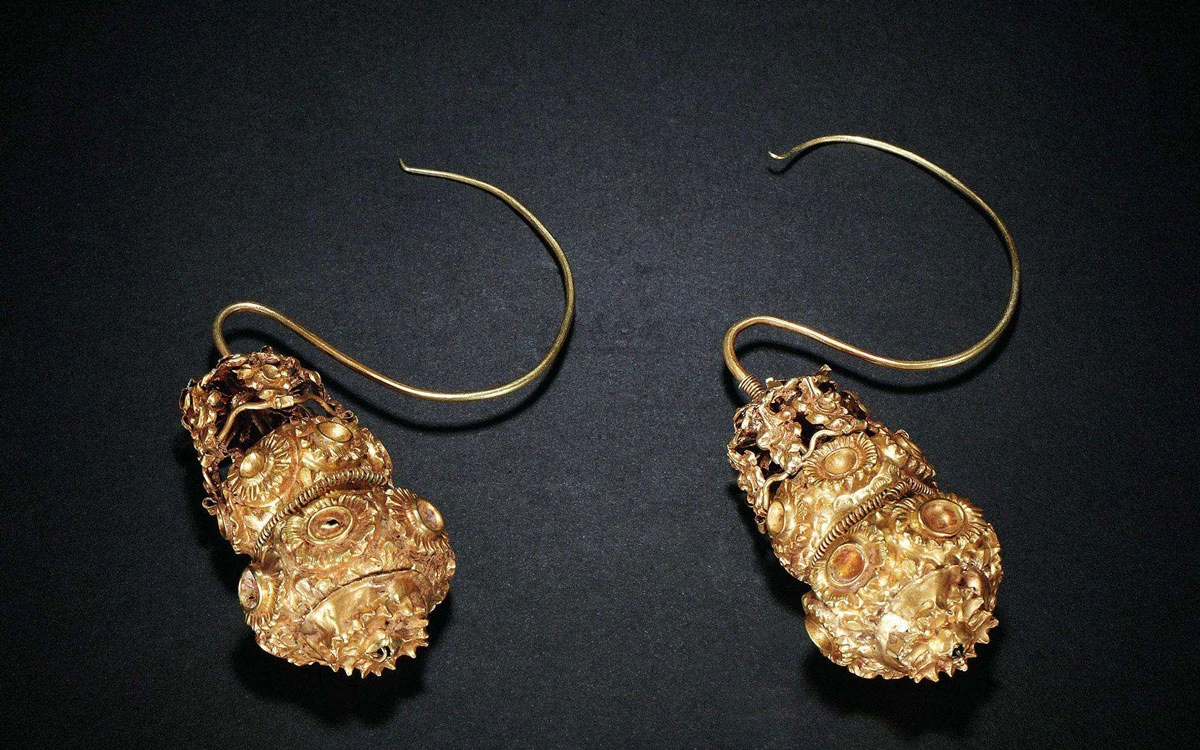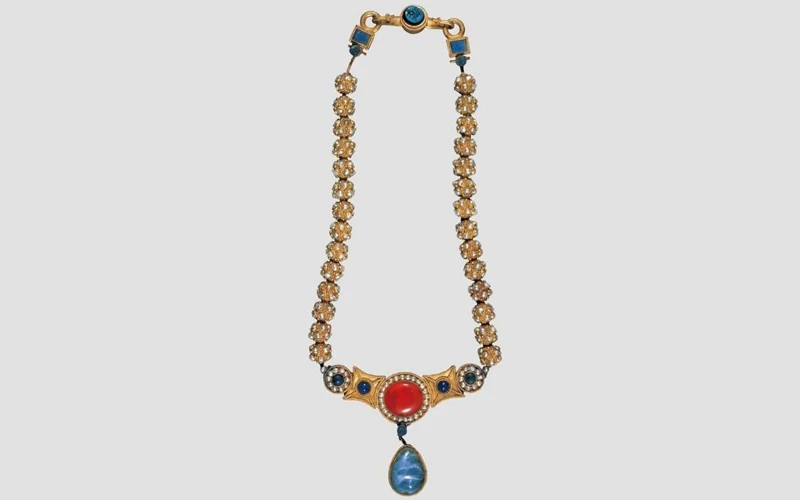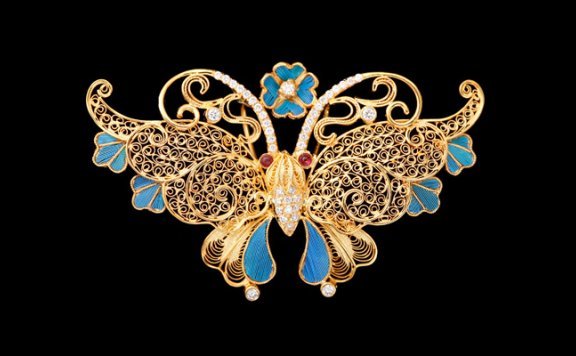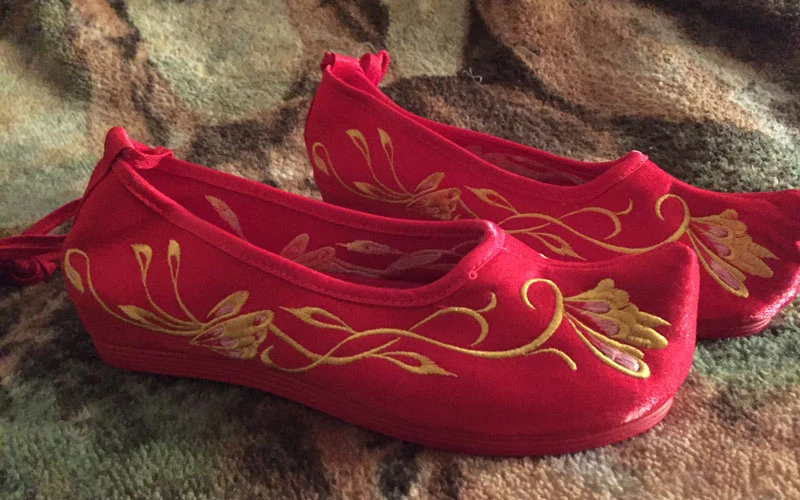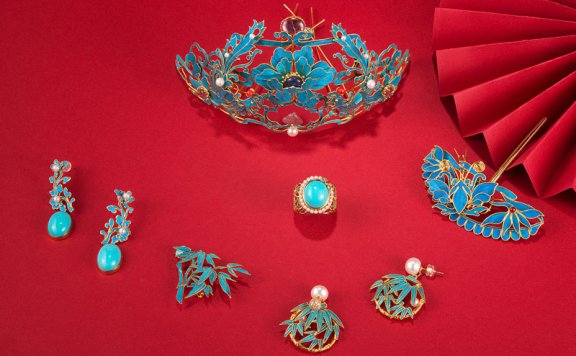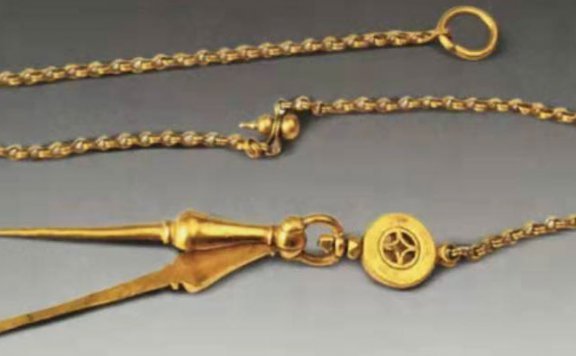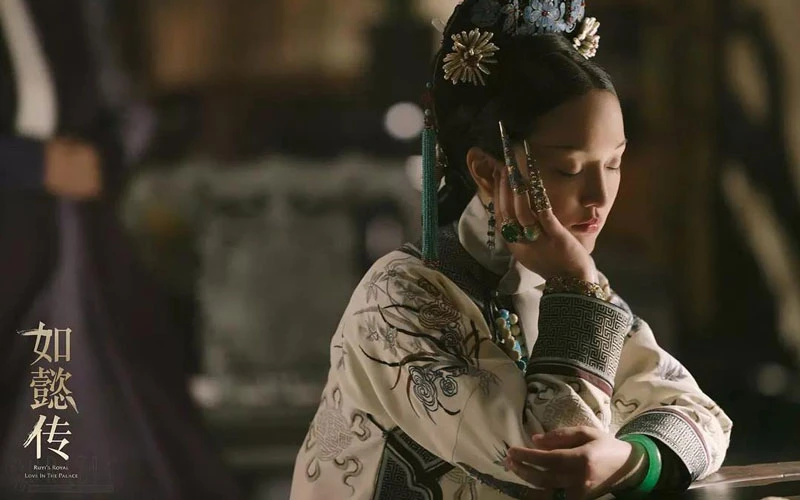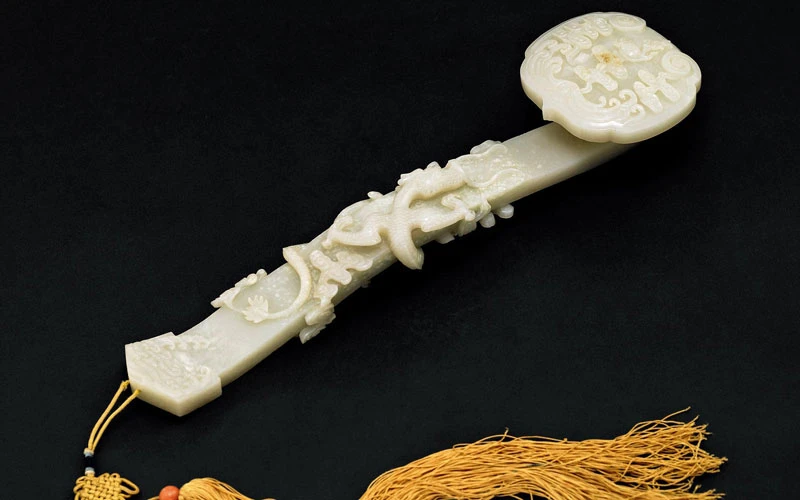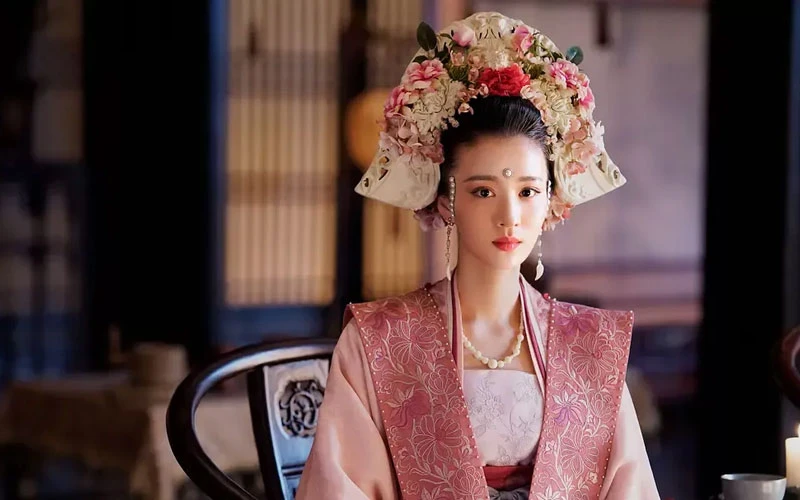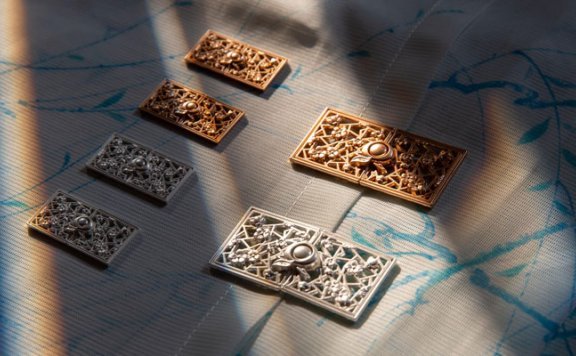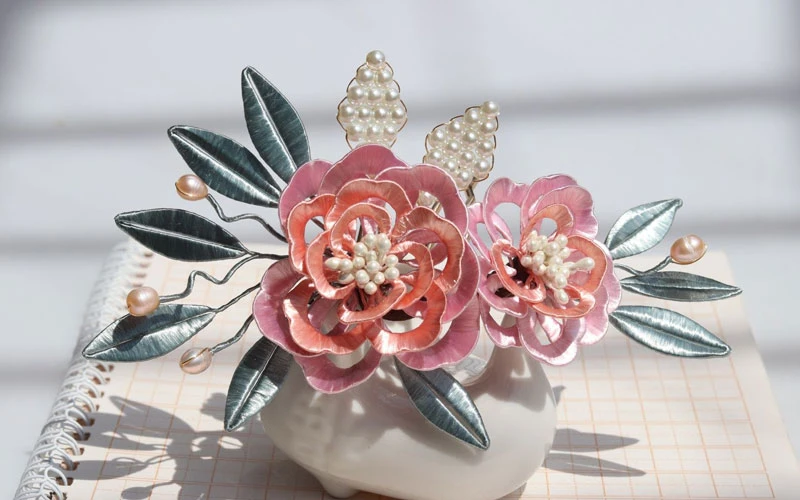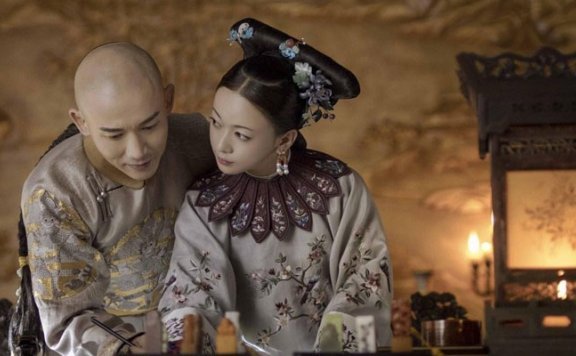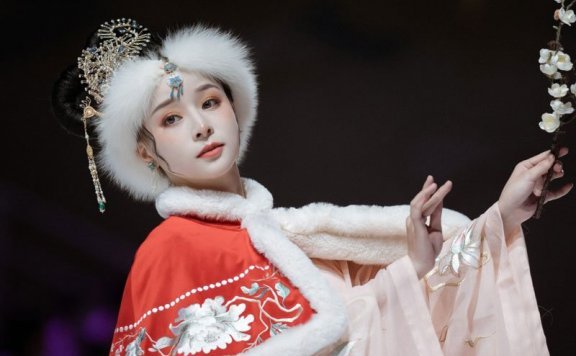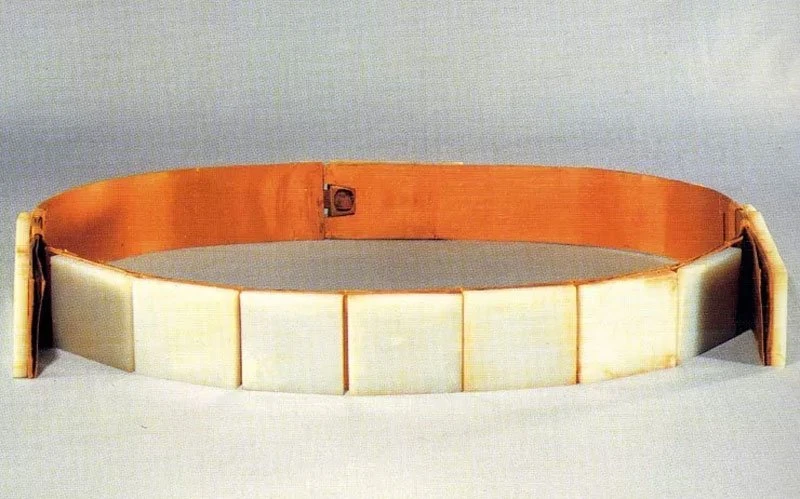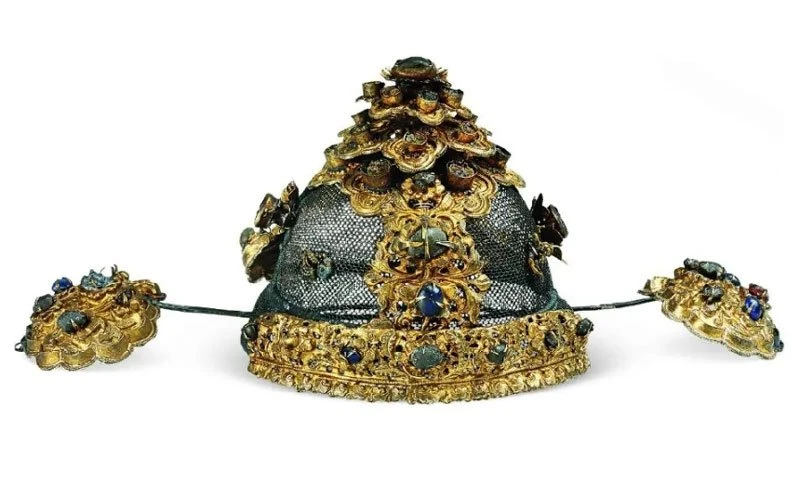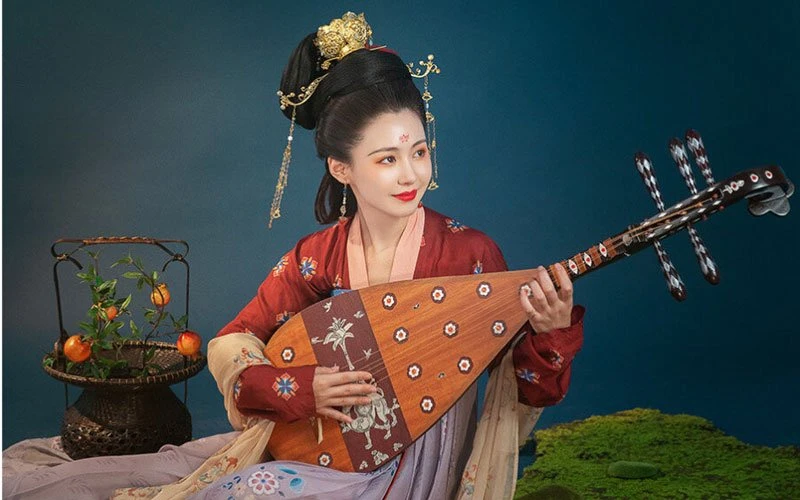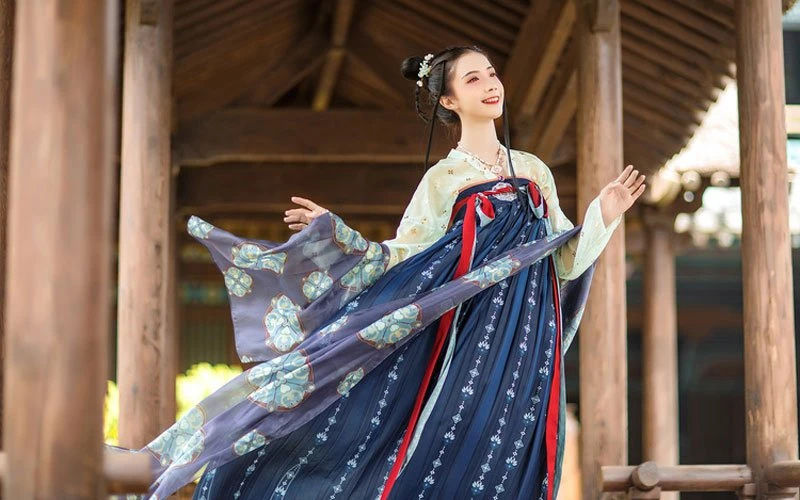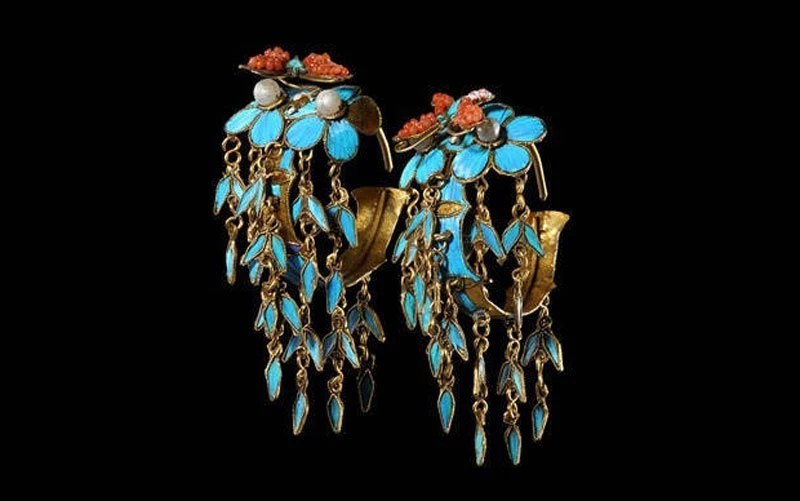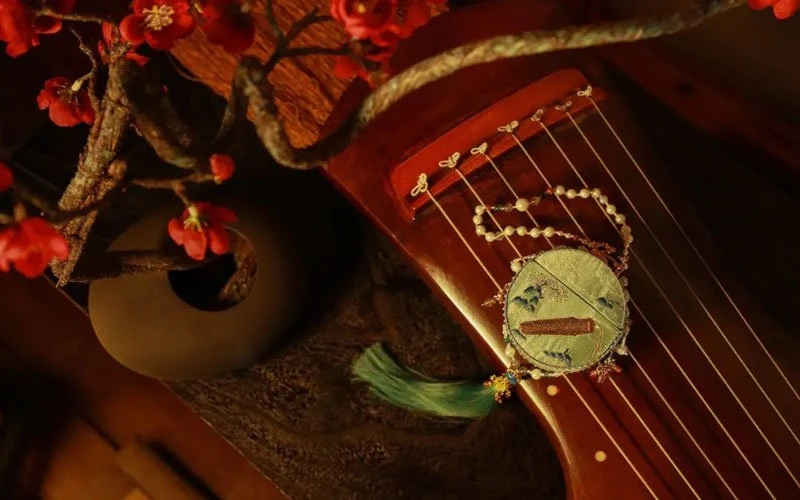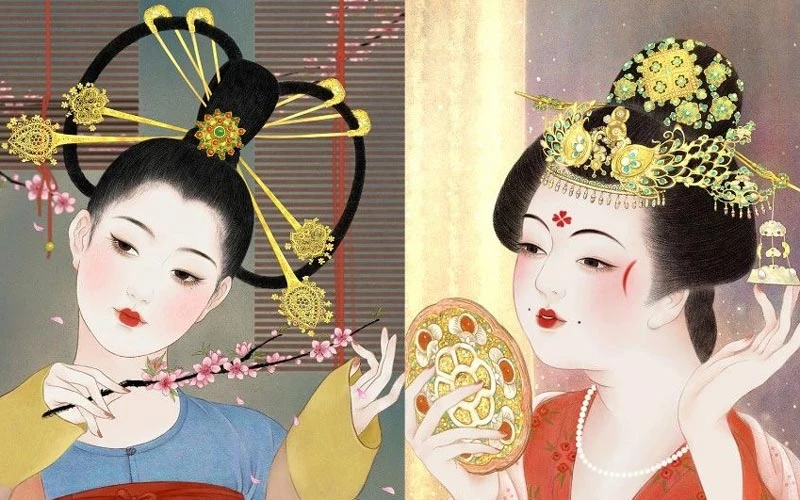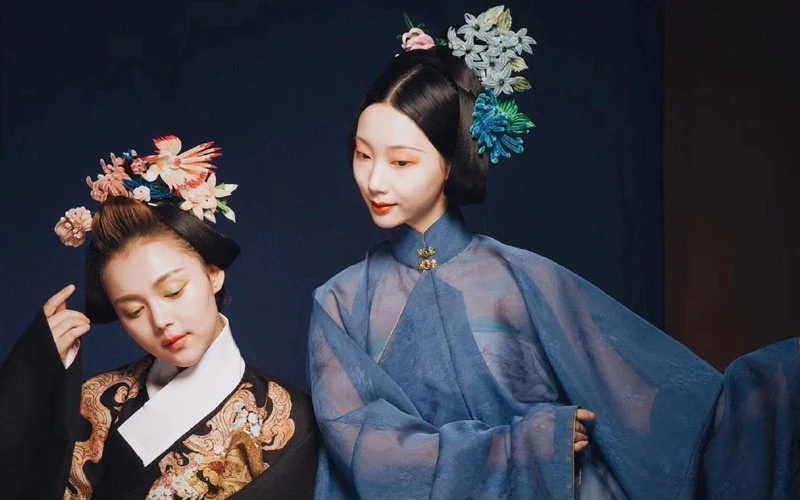-
Christmas Presents for Hanfu Lovers
Holliday season is upon us! Many of you may already be shopping for gifts. If you have hanfu lovers amongst your friends and relatives, or if you need to come up with a list of your own to give ideas to your relatives, here are a few inspirations. My choices went to objects that are: versatile, so you can have a few of the item and use them interchangeably hard to make for yourself, so even if the person makes hanfu for themselves, they would be happy to have one ready-made hard to find in stores but available online useful, no matter how many you have "Mother-child" metal buttons "Mother-child" metal buttons, also know as Zimukou (子母扣). They are so beautiful, there are so many shapes and sizes, and so hard to find in sewing supply stores, especially in Western countries. It adds greatly to the beauty of a Ming dinasty shan or ao, but can also be used on daily wear. Trimmings Especially enbroidered, ancient looking trimmings. They are no longer fashionable for modern sewing supply shops, you can almost only find them online. It adds style to your garment right away, and unless you weave, you cannot…- 257
- 4
-
Hanfu Accessory: Ronghua History and Basic DIY Steps
Vocabulary Velvet Flower - 绒花 (rónghuā) - a realistically made flower made artificially from silk threads and copper wire. Palace Flower - 宫花 (gōng huā) - another way to call ronghua with the rise in popularities of ronghua to females in the palace. Untwisted Silks - 无捻蚕丝 (wú niǎn cánsī) - when it comes to silk threads, depending on the type and material of the threads, one single thread can be made up of thinner threads twisted together. Untwisted silk thread means there are no smaller twisted threads. You can directly skip to the brushing steps in ronghua making process. Hunan Embroidery Thread - 湘绣线 (xiāngxiù xiàn) - another type of thread used in ronghua making. Suzhou Embroidery Thread - 苏绣线 (sūxiù xiàn) - another type of thread used in ronghua making. History 绒花, rónghuā, an artificial handcraft head accessories made from materials such as silks and coppers. It existed since the Qin Dynasty. There are many known “brands” of ronghuas, such as Nanjing Ronghua. In the Tang era, Wu Zetian listed Nanjing Ronghua as a royal tribute to the Yangzhou area becoming a luxury only princes and princesses can use. Eventually, Nanjing Ronghua became something that represents Nanjing but also…- 11.4k
- 12
-
Luxury Aesthetics of Ancient Chinese Gold Jewelry
In recent years, with the rise of the China-Chic trend, many gold stores have also begun to favor products of traditional culture and launched the so-called ancient gold craft and inheritance series of Chinese gold jewelry. The ancient Chinese used goldware as body decoration, dating back to the Xia Dynasty 4,000 years ago. The gold eardrops unearthed in Gansu is the best proof. The simple circle obviously cannot reflect the skill level of the ancients, so today let’s take a look at the gold earrings and gold bracelets in the museum’s collection of cultural relics. Let’s experience the luxury aesthetics of ancient Chinese gold jewelry. Eardrop Eardrops (Er Zhui, 耳坠) is a kind of traditional Chinese earrings, with an additional part of the drop than earrings. This pair of gold eardrops in the Warring States Period adopts a cone and spring design, and the color matching of gold and turquoise is even more ingenious. This pair of gold eardrops from the Northern Wei Dynasty is composed of amber, silver ring, gold ring, silk column, hollow gold beads, wheat ear flower and other elements. Through weaving, welding, hammering, wire drawing, and other technologies, it creates a complicated but not messy… -
History of Chinese Traditional Necklace & Choker
The ancient women left their stunning figures in the ancient poets, and their bejeweled were equally eye-catching. That brilliant hanfu jewelry like a river of stars, will set them off quiet, elegant, highlighting the unique charm. In this article, let's go into the history of gorgeous Chinese traditional necklace and choker and see how the ancient people carried forward the beauty of neckwear. The Ancient Times When our ancestors were still living in cold, dark caves, the sense of beauty was already awakened. They searched for anything that resembled "beads", drilled holes in them, strung them on chains, and wore them around their necks. Some of them were also painted red with hematite powder. At the Zhoukoudian Peking Man site, which is about 30,000 years old, a large number of neck ornaments have been unearthed. These neck ornaments are made of different materials, including gravel, animal teeth, fish spine bones, and bird bones, all of which have been carefully selected and polished. Among them, there is a string of rabbit bone chains, consisting of 12 pieces of rabbit backbone, each of which has a hole for threading. The holes have been worn out and deformed due to long-term wear,…- 1.9k
- 1
-
History of Chinese Traditional Filigree Inlay Art
The magnificent filigree inlay, representing the pinnacle of precious metal production technology, from the old days dedicated to the court, to nowadays spread to the folk, there has been a lot of people contact, wear filigree inlay products, and for its exquisite and intricate technology by. What is Filigree Inlay? Filigree inlay (花丝镶嵌), also known as "fine gold craft", is a long-established traditional Chinese handicraft technique, mainly used in the production of ancient Chinese royal jewelry, by the combination of "filigree" and "inlay" two production techniques. Filigree refers to drawing gold and silver into fine wire, using filling and weaving techniques to make crafts. Inlay refers to the hammering of gold and silver flakes into vessels, and then burin out the pattern, set with pearls or gemstones, and become. As one of the "Eight Unique Skills of Yanjing", the art of filigree mosaic was included in China's national intangible cultural heritage list in June 2008. The objects that can be applied with filigree inlay can be divided into three categories. The first category is jewelry, including bracelets, necklaces, earrings, brooches, pendants, cufflinks, etc. The second category is the display category, mainly indoor decorative items, such as hanging scroll, vase,…- 1.7k
- 3
-
-
Top 10 Most Popular Traditional Accessories in History
Dear veteran viewers of ancient Chinese costume dramas, I'm sure that for everyone, the plot of the hanfu beauty, palace plot, power rivalry, wrongly paid life, and so on has long been known. However, I wonder if you have caught the details to keep up with the fashion trends of traditional accessories throughout the dynasties? For example, what kind of ornaments did Empress Cao put on her face? Another example is that the "tip set" worn on Ru Yi's fingers was for decoration or for something else? And, did the yellow and red powder applied to Mulan's face before the blind date actually exist in history? Also, will this level of hair volume be standard per person? The story of jewelry is long and wide, fine and splendid. We might as well put together a "Top 10 List of Ancient Traditional Accessories Trends" for all the major categories of accessories, based on their length of popularity, usage, and popularity, etc. Since history is too voluminous to be told in one article, this list temporarily selects the mainstream accessories. No.10 Hu Zhi - Nail Guards Hu Zhi (护指), also know as Nail Guards, is the Qing Dynasty drama, the aristocratic…- 1.9k
- 7
-
3 Special Ming Dynasty Ornaments You Never Knew About
During the Ming dynasty, the categories and styles of gold and silver ornaments had greater innovation and development based on the Song and Yuan dynasties, showing different visual aesthetic experiences and artistic styles. Among the various types of gold and silver in the Ming dynasty ornaments, "San Sher (三事儿, sān shèr, three things)" is a unique example. Unlike other ornaments, the "San Sher" are daily life tools, used for repairing and cleaning, and their main components include hooks, chains, connectors, pendants, etc. Some of them also have storage tubes, and the pendant objects are usually toothpicks, ear picks, and tweezers, which can be worn by both men and women. The "San Sher" is a common name in the Ming Dynasty, but in fact, the number of pendants can be increased or decreased, and the types are also different. The Ming Dynasty gold and silver "San Sher" are exquisite and unique, reflecting the high design aesthetic appeal, and also have a rich cultural connotation. Design aesthetics of Ming dynasty Ornaments - San Sher 01 Small and applicable: the form of pendant design The gold and silver "San Sher" of the Ming Dynasty pursued unity in form, and the pendant… -
History and Type of Chinese Nail Guards
Traditional Chinese nail guards (Zhi Jia Tao, 指甲套), also known as "Hu Zhi (护指, finger protection)". The ancient palace noblewomen used gold and silver to make nail guards to protect their nails and show their status, were extremely fine and gorgeous, with a wide variety. If you have watched the wonderful historical TV drama Ruyi's Royal Love in the Palace, you may have noticed that the concubines in the drama have long nails on their slender hands and wear nail guards on their end fingers, showing their nobility and elegance. Such luxurious Chinese nail guards, in addition to showing the identity status characteristics, what is its role, today let's explore it! History of keeping long fingernails Everyone has a love of beauty. Since ancient times, it has been every woman's wish to have a pair of delicate hands, and the ancient Chinese had three main aesthetic standards for women's fingers: pointed, long, and white. The direct purpose of keeping long nails for women in ancient times was to make the nails extend the fingers, making the hand shape look sharp and long. And in ancient times, both men and women pursued long nails for beauty, many noble families and literati,…- 9.6k
- 1
-
What is the Chinese Jade Ruyi Scepter
As a symbol of good fortune, Ruyi (如意, scepter) is a traditional handicraft unique to China that emerged during the Warring States period and has evolved in form and cultural connotation through the Han, Wei, and Jin dynasties, Tang, Song, and even Ming and Qing dynasties. Interestingly, the initial function of the Ruyi is the same as the backscratcher we use today. Only later did it evolve from a practical tool to a beautiful display at a later stage. Origin of Ruyi According to the National Palace Museum, Ruyi originated from the "Sao Zhang (搔杖)" (now called backscratcher) used by the ancients to scratch an itch. The earliest Ruyi, the end of the handle in the shape of a finger, to reach that the hand can not reach, so that can follow heart to relieve the itch, so-called Ruyi. Later, the "Sao Zhang" was combined with "Hu (笏, referring to the hand board used by courtiers to record their business at court)", and the shape gradually evolved into a curved head, and the end of the handle changed from straight to small Lingzhi-shaped, cloud-shaped and other shapes. The head and tail echo each other, the main body is streamlined, the…- 2.2k
- 1
-
Fashion Secrets in Traditional Chinese Jewelry Boxes
A complete hanfu look is certainly not complete without fine jewelry to match. In the course of ancient history, traditional Chinese jewelry naturally evolved, graceful and luxurious, or refined and small. In this article, we will reveal through the order of dynasties, the fashion secrets in ancient traditional Chinese jewelry boxes. Let's see those periods of "China-Chic" how fashionable. Wei, Jin and North and South Dynasties: A Fashion Trend from Abroad? The poem "Ballad of Mulan" contains the line: "She combs her hair by the window and, before the mirror, fastens golden yellow flowers." This "yellow flowers (Hua Hunag, 花黄)" refers to the makeup of women in the Wei and Jin dynasties, which was inspired by Buddhism. Due to the popularity of Buddhism, the Buddha-nature of gold brought inspiration to women, so although the "flower yellow" in makeup may have been a little exaggerated, but it does reflect the characteristics of Buddhism at the time, as well as the pursuit of exoticism. Of course, the rise of the introduction of Buddhism to the fashion circle brought not only makeup, with the matching jewelry also with a clear Buddhist style. In terms of production materials, although gold and silver remained…- 2.2k
- 7
-
Zimu Kou - Exquisite Ming Style Hanfu Button
Zimu Kou (子母扣, metal clasp button) is the most common accessory for making Ming-style Hanfu, and if you make a Ming Hanfu yourself, they are a must-buy material. Usually, you need about 7-10 buttons to make a Duijin Duan Shan (对襟短衫) with a stand-up collar. A good-looking Zimu Kou can become the highlight of the clothes, adding texture and a sense of sophistication, and good clothes should find a matching button to complement each other. About Zimu Kou's selection Metal Zimu Kou is more suitable for autumn and winter Shan and Ao and other outer clothing, but sometimes too thin fabric to support too heavy Zimu Kou. Pifeng's Zimu Kou larger (only one, so need a larger one, can do embellishment, or highlight). Zimu Kou applied to the collar should choose easy to buckle on, the size of the buttons than the size of the garment is a little smaller. Gorgeous button style, more suitable for clothes with woven gold, dark pattern and so on. About the care of Zimu Kou General copper and silver-plated material button are easier to oxidation, over time will become black. Usually to keep clean, dirty to wipe as soon as possible. If…- 1.4k
- 1
-
10 Types of Traditional Chinese Hairpins to Match Hanfu
With the popularity of hanfu, more and more people are starting to pay attention to hanfu, but besides hanfu itself, there is one very important thing to match, and that is traditional Chinese hairpins. There are many kinds of Chinese hairpins, and they are as exquisite as the hanfu, so today we will introduce some of the most beautiful kinds of Chinese hairpins for you. 01 Chan Hua The raw material for Chan Hua (缠花) is silk thread, cardboard, and metal wire. It is a traditional Chinese folk craft, which is mainly made by cutting cardboard into different basic shapes, and then wrapping the wire inside the cardboard with silk thread evenly, and finally bending and combination, a beautiful Chan Hua is completed. The silk thread is used to make the flowers, which are delicate, soft, and elegant. In ancient times, it was an ornament often worn by folk girls. 02 Heat-shrink sheets hairpin The main raw material of the heat-shrink sheet hairpin is a kind of sheet (heat-shrink sheet) that shrinks when exposed to heat and colored powder. The flower petals and leaf patterns are traced on the frosted heat-shrink sheet, cut out, colored with colored pencils… -
Ancient Chinese Headdress Qing Dynasty Bian Fang
Qing Dynasty was the last stage of the highly developed feudal society in China. With the evolution of the dynasty, the Qing dynasty Manchu women's headdress is rich and diverse. Inheritance of headdress in the past generations, but also according to the national dressing characteristics, create jewelry corresponding to it. One of the most ancient Chinese headdress representatives is the Bian Fang (扁方). 01 What is Bian Fang? Bian Fang is one of the traditional hair ornaments in ancient China, which was mainly popular in the Ming and Qing Dynasty, used to fix hair. The shape of its head is generally curvy and its body is often 1-shaped. They have different shapes, large, small, wide, or narrow. The large one can reach more than 30cm. The small one, also known as double-tip, can be used as hair fixing or decoration. The large one is used to fix "two buns head (两把头)". Let's take a look at the evolution of women's hairstyles in the Qing Dynasty! Before the Qing Dynasty, Manchu people originally lived in the northern region, influenced by the environment, has long been accustomed to fishing and hunting, farming lifestyle. In order to move quickly and easily, easy to…- 2.7k
- 1
-
5 Hanfu Accessories for the Cold Winter - Warm & Adorable
This year's winter seems to be a little colder than expected, so I'm sure you are all ready to meet 2021 in Hanfu! But accessories naturally can not be ignored, follow the Tongpao App today to learn about some Hanfu accessories for the cold winter and the wear tips! Whether it's a location shoot or daily wear is very practical to help you stay beautiful and stay warm. Berets Beret in Hanfu wear more and more common, can easily with different Hanfu style with, add fashion sense, and beret in the winter utilization rate is super high! The most important thing is: (wear beret can save to do Hanfu hairstyle steps). Matching tips Tweed beret will be more suitable for most Hanfu, the solid color beret is better with. Or choose a piece of Hanfu / accessories together with similar color, neighboring color, so that the visual will be more harmonious, can also try to collision color. Wotuer / Zhaojun Tao Wear beret still feel not warm enough? Then you may need, Wotuer (卧兔儿) or Zhaojun Tao (昭君套). Warm and good-looking, and with super show face small, but also can cover the hairline. Hanfu girl's winter essential accessories. Matching tips…- 836
- 0
-
History of Peizhui - Most Exquisite Hanfu Ornament
When we introduced the Xiapei during the Song and Ming dynasties, we mentioned that the Xiapei hangs flat in front of the chest. The creation of Hanfu ornament: "Peizhui (帔坠)" is to ensure that the Xiapei (霞帔) is flattened in front of women's chest and belly when they move, maintaining a dignified image. Nowadays, you can often see girls who like Ming-style Hanfu hanging their Peizhui pendant around their neck for decoration. As an important part of Song and Ming women's costumes, the historical Peizhui pendant is integrated with the Xiapei, which serves the function of beautifying decoration and distinguishing social hierarchy. In the excavated tombs of Song, Yuan, and Ming dynasties, the silk fabric of Xiapei is not easy to be preserved, but the gold, silver, and jade quality of Peizhui has been preserved. Today, let's learn more about Peizhui pendant, a precious Hanfu ornament! Peizhui is usually made of two patterned curved pieces that are fastened together and attached to the end of the Xiapei in front of the body. The patterns are mostly hollow, often mistaken for scented sachet when unearthed earlier. The Peizhui unearthed in Song, Yuan, and Ming tombs are mainly made of gold, silver,… -
History of Hanfu Sash & Belt Ornament in Ancient China
In the ancient Chinese costume system, Hanfu sash and belt ornaments played a very important role, not only as a means of securing and decorating the garment, but also as a symbol of the wearer's status. In ancient times, officials wore Chaofu (朝服) when going to Shangchao (上朝). The Chaofu was the ancient official's uniform for political discussions, one of the important functions of Chaofu in ancient China was to distinguish between the ranks of superior and inferior through clothing. This distinction was mainly made through the three aspects of the Guan (冠, headwear), the color/Zhangwen (章纹) of the garment, and the belt ornaments. The belt ornaments on Chaofu, specifically the belt and the various types of pendant hanging from it, are mainly of the following types: jade pendants, Bixi (蔽膝), Yinshou (印绶), and Yufu/Yudai (鱼符/鱼袋). In ancient Chinese Chaofu, belt ornaments were a very important part, especially for men, as they were almost the only ornaments they wore and were important identity markers. The role of the belt ornament in expressing the wearer's rank was clearly and straightforwardly defined in the costume system during the Zhou dynasty, and was later enriched and refined through the ages. Hanfu Belt for…- 6.5k
- 3
-
Traditional Chinese Hair Jewelry - Ming Style Diji & Tiaopai
Diji and Tiaopai are two magnificent pieces of traditional Chinese hair jewelry, often paired with Ming-style Hanfu. The Ming dynasty was one of the most commercialized periods in ancient Chinese history, particularly in the Jiangnan region. From the point of view of hair jewelry, the most significant change shown in gold and silver jewelry during the Ming dynasty, compared to the Song and Yuan dynasties, was an increase in the number of types and styles, and a more detailed distinction in names. Various types of traditional Chinese hair jewelry, have different names, depending on where they are worn, or on their decoration, style, and even their length. Today we will focus on the Diji and Tiaopai. Diji (䯼髻, dí jì) [History and structure] Diji is a new type of wig bun that appeared in the Ming Dynasty, generally made of gold and silver wire or horsehair, and hair, covered with soap-colored yarn and worn over the top bun. The appearance of the Diji was influenced on the one hand by the wearing of Guan by women from the Northern Song Dynasty onwards, and on the other by the popularity of the 'Baoji (包髻)' hairstyle during the Jin and Yuan Dynasties.…- 2.1k
- 1
-
History of Traditional Chinese Hair Accessories
As the old saying goes, "Men are willing to die for those who appreciate them, and women are willing to makeup for those who appreciate them". From ancient times to the present, women have always been the trendsetters in the pursuit of beauty. From Chinese traditional clothing to Hanfu makeup to various accessories, each item has passed through history and left a strong mark in the history of women's lives, becoming a classic art appreciation. Previous articles on traditional Chinese earrings have already done some telling about women's earrings and their culture from ancient times to the present, but today we're going to talk about the history of another type of ornaments - traditional Chinese hair accessories. Derivation of the traditional Chinese hair accessories In ancient China, Confucianism was the orthodox idea of the society, emphasizing "ritual". Hair, as part of the body, is considered unclean and rude if it is disheveled. Therefore, men at the age of 15 years need to tie the hair as a bun, women at the age of 15 years need tie hair as a bun and wear Ji (笄), already a kind of "ritual" custom in ancient time. As to when the custom…- 17.1k
- 7
-
History of Chinese Traditional Hanfu Shawl: Pibo
Pibo (披帛, pī bó), traditional Hanfu shawl, made from light fabric silk, although now the Hanfu enthusiasts accustomed to call it Pibo, but the name "Pibo" actually appeared later, about the late Tang Dynasty, more often it is called Pei (帔, pèi). In earlier Chinese dramas, Pei was once the symbol of "Chinese ancient costume" with its elegant and beautiful features. In the wardrobe of ancient women, Pei has always been very distinctive and not to be ignored part, wrapped between the arms or draped over the shoulders and neck. Also in Chinese wedding customs, there is "Fengguan Xiapei (凤冠霞帔)", different eras of Pei also have different styles. So how has Pei changed over its long history, and what role has it played? Follow along with Dongfang Zhuangdao to find out more. Traditional Hanfu Shawl Pei before the Song Dynasty Pei, a long silk shawl worn by women in ancient times, is thought to have originated during the Qin and Han dynasties, the more accepted theory is that it was influenced by Buddhism and Metaphysics and originated from the Dajin (搭巾) worn by figures in statues. Since the beginning of the Northern and Southern Dynasties, in the context of ethnic…- 4.6k
- 2
-
History of Chinese Traditional Earrings
Chinese Traditional earrings are of various types, both decorative and ceremonial, and have been an indispensable part of people's decorations since ancient times. The popularity of Chinese Traditional Earrings The first appearance of earrings can be traced back to the Neolithic period. At that time, people's craftsmanship was limited to a certain extent, so earrings were usually in the shape of simple rings with notches and were called "Jue (玦)", mostly made of jade, but also bone, stone, agate, and ivory. Later, with the development of dynasties and civilizations, earrings became richer in style, with different styles such as earrings, earrings pendants, and so on. However, earrings have not always been a symbol of beauty in a long history. In ancient China, women's status was far inferior to men's, so people came up with the idea of piercing holes in women's ears and hanging earrings to remind them to act cautiously, in order to restrain their behavior. In the olden days, until a girl was 10 years old, her mother or other elders would repeatedly be grinding with rice grains over the girl's earlobe to numb it, then pierce it with the tip of a needle, and then wear a piece…- 10.7k
- 1
-
The History of Chinese Traditional Scented Sachet
Chinese incense culture has a long history. As an important part of incense culture - Chinese traditional scented sachet culture, it also carries a large amount of cultural information, reflecting the aesthetic concepts and social customs of people in different periods, as well as the achievements of Chinese textiles and fine manufacturing. Nowadays, due to the emergence and use of aromatherapy, perfume, and other items, incense sachets have rarely been used except on specific festivals and occasions, but they have left a strong mark in the history of incense used in China. The History of the Traditional Sachet Scented sachet (香囊, Xiangnang) is a folk embroidered craft created by ancient women, originally developed from Peinang (佩囊), a small cloth pocket used by the ancients to hold small objects. There were no pockets on the clothes of the ancients, so some portable necessities, such as seals, hand towels, coins, etc., were stored in this kind of pouch, and when they went out, they put it on their waist, so it was called "Peinang". Scented sachet belongs to a kind of Peinang, which is named after the spices stored in the sac. According to the literature, the history of wearing scented…- 7.6k
- 1
-
Hanfu Jewelry | The Legendary Life of the Sui and Tang Royal Ladies
It is every woman's nature to love beauty, and modern women have a common hobby - buying jewelry, and when they see jewelry with good design, they are always delighted and want to buy it as soon as possible. Hanfu girls are no exception, and they often use different styles of Hanfu jewelry to match their Hanfu when they go out in Hanfu clothing. For women, Hanfu jewelry is the best weapon used to adorn themselves and shine in the crowd with elegance and beauty. But you may not realize it, the Sui and Tang dynasties' women were much more particular about Hanfu jewelry than we are today, especially the high officials and noblemen of the time. The aristocratic ladies in their gorgeous clothes, who dressed up every day like "a lotus flower", looked like a pair of beautiful paintings from afar. Archaeologists have studied many Hanfu jewelries that were unearthed during the Sui and Tang dynasties, and from behind those artifacts, they have discovered that the women who wore those gorgeous Hanfu clothing actually had a legendary life story that was hidden from the public. In the following pages, we will talk about the trend of the unearthed Sui…- 2.7k
- 0
-
4 Beautiful Artificial Flowers in Han Fu Hair Accessories
Artificial flowers have become one of the hair accessories of choice for more and more girls in Han Fu. Artificial flowers are fake flowers, in ancient times, people love to pin flowers in the temples, with hair to retain the beauty and fragrance of the flowers, just flowers will soon wither, and it is compared to the fake flowers are both durable and beautiful. The ancients called the seasonal flowers "living flowers" and the artificial imitation flowers "like living flowers", and later called them "artificial flowers". The Song dynasty maidens in the Statue of the Empress of the Dynasties have elaborate and gorgeous flower crowns, just like a moving garden. Today we're going to talk about the artificial flowers in Han Fu hair accessories! Han Fu Hair Accessories: Silk Flowers The origin of silk flowers began in the Tang Dynasty, more than 1,000 years ago. According to legend, Tang Emperor Xuanzong Li Longji's favorite concubine Yang Guifei had a scar on her left temples, and every day she would let her maids pick flowers to wear on her temples. However, in the winter, the flowers began to fade. A clever maid made fake flowers out of damask and silk…- 1.5k
- 0
